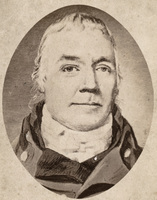 | Back to e-WV
| Back to e-WV
 The West Virginia Encyclopedia
The West Virginia Encyclopedia
 | Back to e-WV
| Back to e-WV
 The West Virginia Encyclopedia
The West Virginia Encyclopedia

Pioneer George Clendenin, born in Augusta County, Virginia, in 1746, was one of the first settlers in the Kanawha Valley and the founder of Charleston. His family settled in the Greenbrier Valley in 1771, and George first saw the Kanawha Valley when he accompanied Andrew Lewis on his march to Point Pleasant in 1774. Clendenin purchased a 1,030-acre tract on the north side of the Kanawha above the Elk, in the heart of present Charleston, from Judge Cuthbert Bullitt of Prince William County, Virginia, in 1787. Commissioned by Virginia Gov. Edmund Randolph, the Clendenin family, led by George, left Camp Union with 30 Greenbrier County Rangers on April 1, 1788, and arrived in the Kanawha Valley a month later.
As frontier defense was a major concern for western settlement the group set about constructing a stockade, a two-story fort, and sturdy cabins for protection against Indian attacks. This ‘‘fort at the mouth of the Elk’’ or ‘‘Clendenin’s Station’’ later became known as Fort Lee. Through Clendenin’s influence the Virginia Assembly authorized the formation of Kanawha County from parts of Greenbrier and Montgomery counties in 1788. On December 19, 1794, a 40-acre tract of Clendenin’s land was selected and named Charlestown in memory of Clendenin’s father, Charles. It was later renamed Charleston. By 1795, George became disappointed and embittered with the government in Richmond and sold his Charleston land holdings and moved to the mouth of the Kanawha on the Ohio. He died in Marietta, Ohio, in 1797 while visiting his daughter.
Written by Cathy Hershberger Miller
DeGruyter, Julius A. Kanawha Spectator. Charleston: Jarrett Printing, 1953.
Morgan, John G. & Robert J. Byers. Charleston 200. Charleston: Gazette, 1994.
Rice, Otis. Charleston and the Kanawha Valley. Woodland Hills, CA: Windsor Pub., 1981.